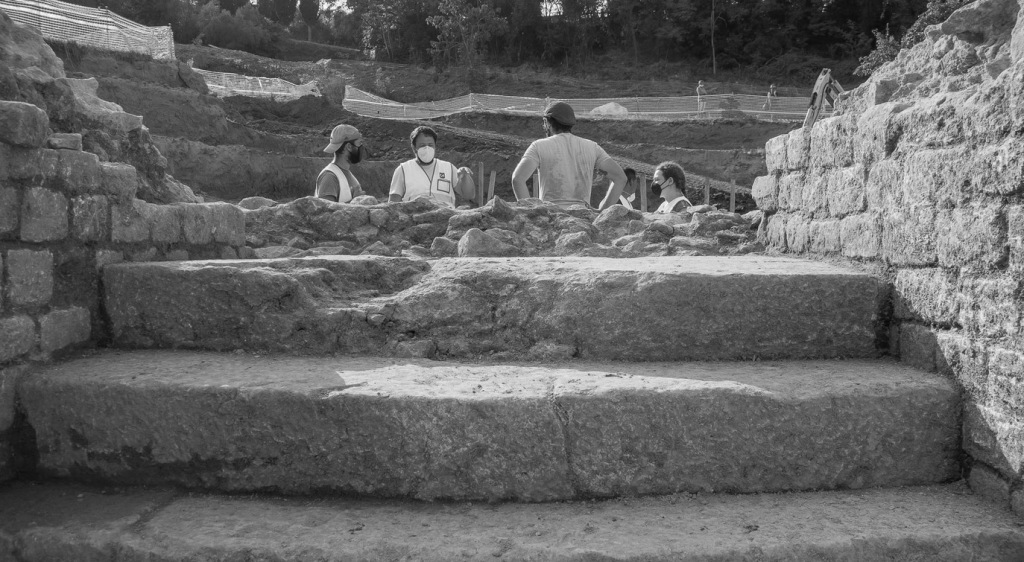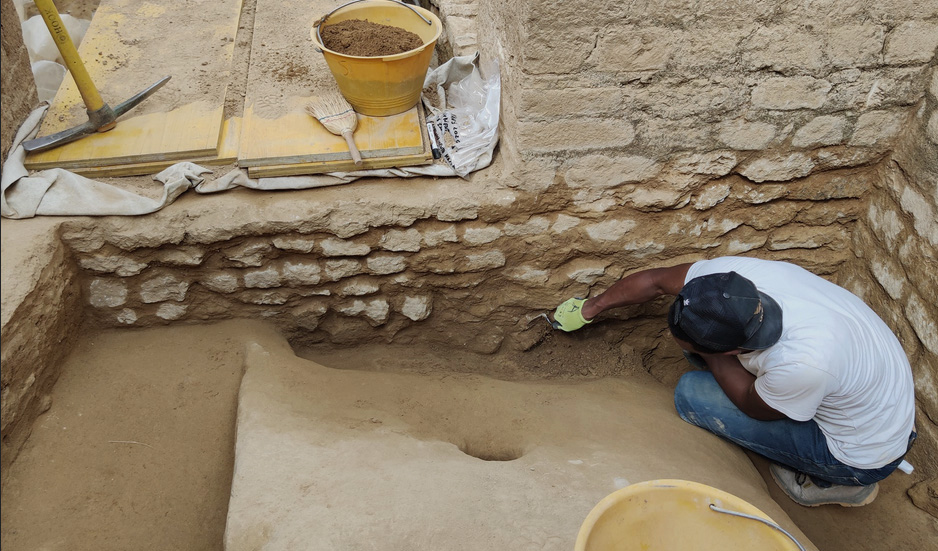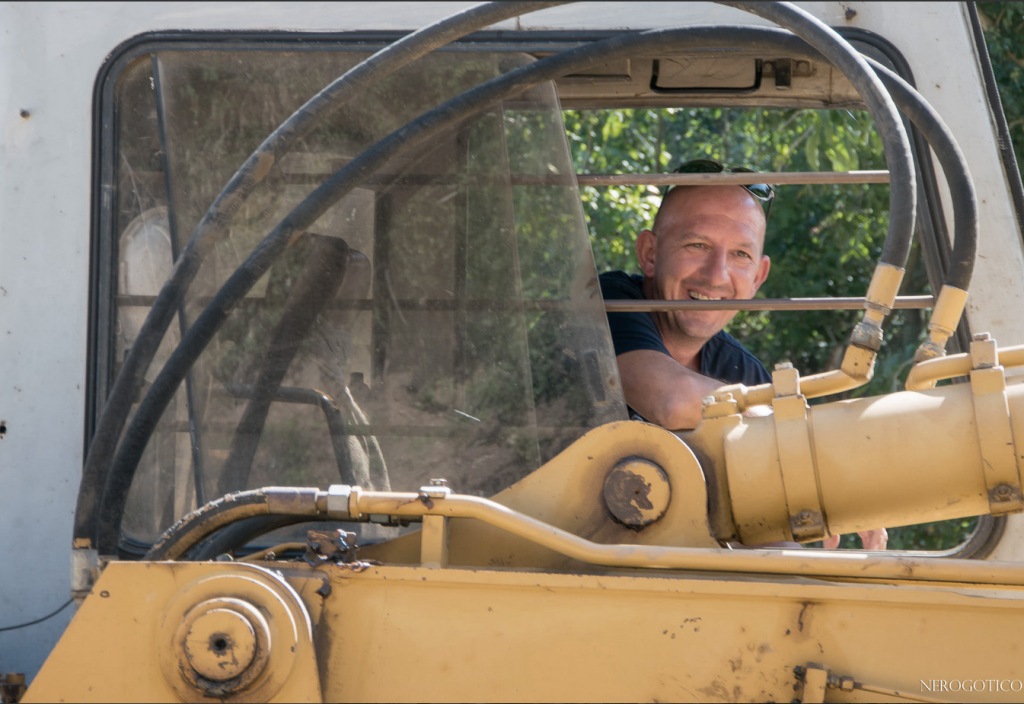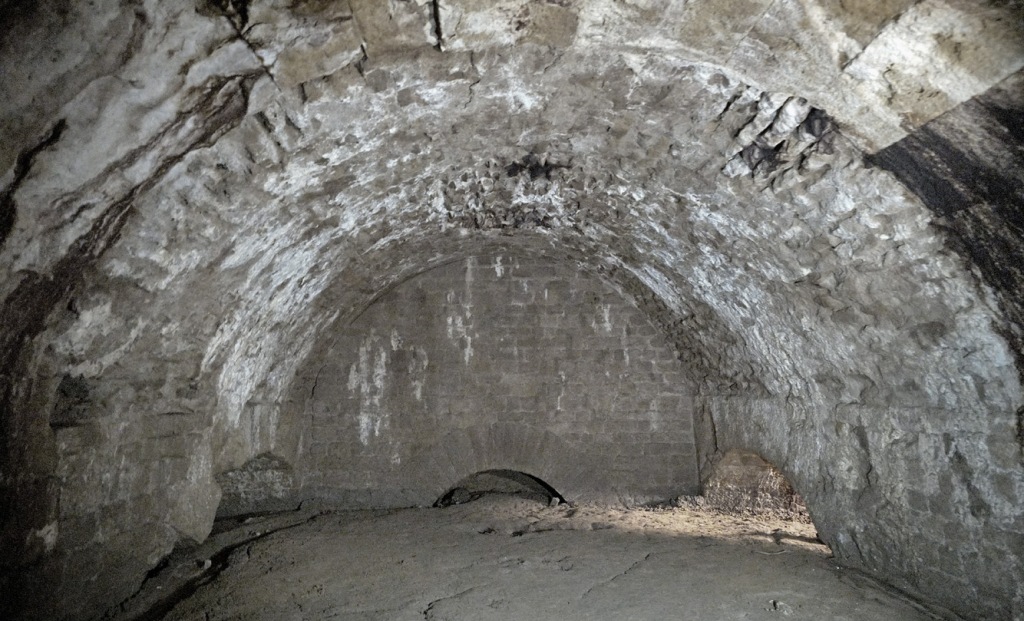It’s not every day that you discover an ancient Roman amphitheater. Actually, it’s not even every century that you make a discovery of this kind. Not even in Italy. Volterra’s newly discovered amphitheater is starting to send shock waves through the archaeological community as the magnitude of this discovery is further revealed with the continuing excavation.
Although the amphitheater was first identified in the summer of 2015, just a few weeks ago a few surprising discoveries, including the existence of a 15-foot walkway with a perfectly intact vaulted ceiling leading to the main entrance, suddenly brought the excavation back into the national spotlight. This is a serendipitous discovery for Volterra, a city in the running to be named Italy’s Culture Capital for 2022.
Measuring 82 by 64 meters (270 x 210 ft) and most probably constructed in the early 1st century CE, Volterra’s amphitheater is not the biggest ever discovered (that would be Rome’s Flavian amphitheater, better known as The Colosseum), nor is it the oldest (the amphitheater in Pompeii from 70 BCE can claim that title), nor is it the grandest of amphitheaters (Pozzuoli, Arles, Nimes, Pula, Verona and Rome’s Colosseum are the top contenders).

In Tuscany Volterra’s amphitheater is the best preserved of all, and the only amphitheaters similar in size or larger would have been in Lucca, Florence and Arezzo. But what makes Volterra’s amphitheater utterly unique is the fact that no one in the past millennium knew of its existence; and that means that the latest theoretical and scientific developments in the field of archaeology can be put to the test without contamination or interference from previous excavations. Of the 230-odd Roman amphitheaters known in the world today, almost none of them were “discovered”, simply because their remains were never lost, but were transformed by human interaction for most of their existence.

I spoke recently with Giorgio Pocobelli, a researcher with the Italian National Research Council (CNR) and one of Italy’s leading experts in ancient topography who is one of the key members of the team leading the dig. Pocobelli’s adrenaline was palpable as he told me how exciting it is to have “an amphitheater discovered in modern times excavated with modern technology and methodology”. It is mind boggling to contemplate the possibilities of what could be learned here.
For nearly a thousand years the amphitheater lay forgotten under a field below the town cemetery, just within the ancient Etruscan walls that also served as the city’s boundary in Roman times. There is evidence of early Medieval plowing in the upper strata of the excavation. It seems that is the last time it witnessed any human activity. From the initial survey in 2015 led by Elena Sorge, head archeaologist for the project, it was evident that the amphitheater was quite intact, but since the dig resumed in July 2020 it has become clear that the structure is actually in an extraordinary state of conservation.

THE EMOTION OF DISCOVERY
It is as if the amphitheater had been in a cocoon, lying dormant, waiting for someone to break the surface to let it emerge. It is fitting then that it was discovered by a woman whose last name, Sorge, means to arise and spring forth. It was in 2015, while preparing drainage ditches near the ancient Etruscan gate of Porta Diana, that an excavator hit a mound of rocks just below the soil. Work stopped, and Sorge was called in. This was not the first time she received a call of this kind – in the area around Volterra if you dig underground you know you will most likely find something – the only question is if it is Medieval, Roman, Etruscan, or even from the Bronze Age.
It was clear to Sorge that they had found a Roman wall, and after just a few days she realized that the wall extended well into the adjacent field, forming what seemed to be an oval.
“The first thing I did was to look for someone who would tell me I was just dreaming, that it wasn’t true. Two colleagues specialized in Roman archaeology came, and they looked and they looked and finally came to me saying “Elena, brace yourself… you really have found an amphitheater!” I didn’t sleep a wink that night, overwhelmed by the enormity of it all, by the emotions, and this huge sense of responsibility.”

But this is far from the only aspect that makes Volterra’s amphitheater important. Researchers are learning things not only about how amphitheaters were built, but also about Volterra’s role in ancient Rome.
“It is like opening a chocolate egg with a surprise inside every single day. It is truly a unique feeling that’s just more than anything you could imagine. You think you’ve discovered the best, and then there’s always more. It is pure joy to be there, mixed with a huge sense of responsibility, and the fear that we might not be able to continue, that we might not find enough financing… but I remain hopeful.”
Elena Sorge, the archaeologist who made the initial discovery and continues to lead the project
After all it isn’t a vase or a tomb that’s been discovered, but an amphitheater.
AMPHITHEATERS: ICONS OF ANCIENT ROME
The amphiteatrum, the “theater all around” was a Roman invention. While throughout the Republic Romans enjoyed adaptations of tragedies and comedies and the occasional satire in their Greek-inspired theaters, the entertainment in these semi-circular structures was primarily geared to the elite. By the 1st c. CE time had come for a Roman place of entertainment, and it would have to be bigger – and better – and appeal to the masses. To make something bigger they essentially put two theaters together to create an oval, the shape of all Roman amphitheaters. To make something “better” they did away with most theatrical performances and introduced spectacles that would enthrall the masses: blood and guts entertainment.
“Bread and Circuses”, wrote the Roman poet Juvenal, is what the people anxiously await. And usually it’s what they got. From chariot races and athletic competitions at the circuses, to gladiatorial and animal fights at the amphitheaters, both emperors and the elite frequently sponsored spectacles in Rome and in the provinces. The average Roman came to expect this entertainment, and it was also a wise investment for those wanting to gain popular favor.
The shows put on in the amphitheaters were particularly suited as vehicles for propaganda: on game days, they usually started with the venationes with wild and often exotic animals slaughtered by trained hunters, followed by the gladiatorial contests, and often concluding with the public execution of criminals in a long list of atrocious fashions including cremation, crucifixion and being torn apart by wild animals.

With the games often featuring men and beasts from the farthest corners of the known universe, spectators were invited to contemplate just how enormous the Empire had become. By unleashing the wrath of Rome with creatively horrific executions of traitors and criminals to the cheers of Roman hooligans, it was also clear what would befall anyone who dared rebel against Rome. This was a key aspect of the Roman recipe for stability.
Nothing is more Roman than an amphitheater.
“The amphitheater really represents the legacy of Rome better than any other kind of monument. It’s pure Rome. It’s a Roman invention, and an expression of Roman culture.”
Elena Sorge, head archaeologist at the Volterra dig

THE AMPHITHEATER IN VOLTERRA
Volterra’s amphitheater could seat about 10,000 spectators. They sat on three tiers of stone bleacher seats facing the arena. Much like in stadiums today, the sections were a reflection of social status: the ima cavea is the lowest, where patricians and senators would sit; the media cavea is the middle section, where the middle strata of society could sit;and the summa cavea, which was the nose-bleed section for the plebs.
The dig has uncovered about a quarter-section of the cavea, and has recently revealed the top of the podium wall that separated the cavea from the arena beneath. The team has recently found a narrow service corridor running the inner perimeter of the seating area used by those with the unenviable job of having to clean out the arena after the fights. They’ve already descended about 21 feet from modern ground level, but there is still much to be done until they reach the arena floor.

The amphitheater was built with panchina, a local stone that was also used to construct the city’s Roman theater, the Teatro Romano di Vallebuona, and ancient walls. Panchina is a very robust sandstone that has the peculiar characteristic of being easy to cut, but hardens on contact with the air, which is ideal for posterity. Though the structure may have been covered with marble, little evidence of this remains. In the centuries following the fall of Rome marble was usually the first material to be “reused and recycled”. The entrance to Volterra’s 12th c. cathedral was built with marble always assumed to have been taken from the Roman Theater, though it is possible that the source may have been elsewhere, including even this amphitheater.
It is difficult to guess much about the amphitheater that still lies underground, since each meter of the dig has brought forth surprises. Sorge explains: “In many cases, you can see that amphitheaters were built in series, like with a cookie cutter. Once you’ve seen a sector – let’s say you excavate a quarter of an amphitheater – then you just have to multiply that to get the rest. Here, on the other hand, no two meters are the same. Even the techniques used are extremely diverse, all throughout the structure. And this is something that is simply extraordinary from a scientific perspective.”


Evidence seems to date the structure in the early Empire, suggesting the amphitheater was built around the same time as the city’s theater. For a city to have both of these important public venues in use in the same period tells us that Volterra was certainly a vibrant city at the time.
RECENT DISCOVERIES
In early September the archaeologists were carefully removing stones and dirt from an upper-level corridor that had collapsed in centuries past when a small fissure appeared in the ground. On their hands and knees they gently enlarged the fissure in the sandy soil with their trowels. The top stones of an arch appeared. A flashlight was pointed into the opening and silence reigned as goosebumps covered their skin. Beyond this thin layer of soil lay a long and perfectly-preserved grandiose walkway, free from debris. It looked like a ambulacrum that could have been abandoned just a few years prior, if it weren’t for the stalactites hanging from its vaulted ceiling. The euphoria of the moment lingered over days as they enlarged the hole so Pocobelli and Sorge could harness up and descended into these spaces that no one had touched, seen – or even breathed in – for over a thousand years.
“When I entered the first time I tried to speak but I couldn’t find the air… in this place closed to the world, I was the first person breathing its air. Now it is different, you can breathe more easily, but that also means we have altered its microclimate.”
Elena Sorge, archaeologist for Pisa & Livorno provinces at the State Superintendence for Archeology

Imagine yourself in a harness, hardhat on your head, flashlight in hand. You sit on a hill of dirt under a 2,000 year old arch, and carefully slide down the hill into a hallway, with the perfectly-cut stones of its vaulted ceiling towering over your head. You take a deep breath, as if to breathe in the wonder of it all… but you discover the air is heavy. You take a moment to calibrate your breathing and move on. At the end of the hallway you have to lie down on your belly to slide through a small opening between the floor and an archway, realizing the walkway must have led down to a lower level. Beyond the arch you find yourself in a room where the vaulted ceiling is dotted with stalactites, so close you could touch them. But as you look down and see three arches with just the tops visible, you realize the room has been filled with dirt; the arches would have been high above the heads of spectators as they entered the room from the main entrance corridor (the vomitorium), or from the passageway facing it, descending the stairs to the arena, or climbed the stairs back through the room where you entered to reach the upper rows of seats.
It isn’t hard to imagine tunic-clad Romans clamoring down the walkways in their laced-up sandals, anxious to find their seats for the day’s shows.
As one of Sorge’s colleagues remarked “This is the Disneyland of archaeology – this is pure entertainment! You just keep finding staircase after staircase from one level to the other, it feels like your in a work by Escher.”

REWRITING HISTORY
The existence of this amphitheater means that the Roman chapter of Volterra’s history needs to be rewritten. Historians have always painted a picture of Roman Volterra as a small provincial town, in certain decline from its glory days in Etruscan times. But this doesn’t fit with the picture of Volterra that is emerging. Amphitheaters were not built in the boondocks. As Sorge told me, “you only find amphitheaters in the important urban centers”.
For a city to have an amphitheater built around the same time as a theater, as well as a large underground cistern and several public baths, tells of a considerable investment in public works, suggesting not only a growing population, but also a powerful economic center with people worth impressing with what “Rome does for you”.

Today most think of Volterra as a sleepy Tuscan hill-town, and yet, as Pocobelli says, “clearly the idea we have of Volterra today is not the same as that of people in ancient times.” So we tend to underestimate the importance of Volterra in centuries past. In fact, for most of its history, Volterra was indeed an important center of trade and commerce thanks to its proximity to the sea and ports (just a 6-hour walk) and wealth of resources (minerals in the hills to the southwest, salt deposits in the valley, alabaster all around and fertile land for grain, wine and oil production). It’s therefore no surprise that the Bishop of Volterra, who owned or had right to taxation on most of the land, was usually one of the wealthiest individuals in Tuscany throughout the Middle Ages.
THE NEXT STEP
Amphitheaters weren’t built in a day, nor can they be excavated in one. But if adequate financing is secured, the dig can be completed in just a few years. And the faster they excavate, the fewer the risks.
Sorge explains: “though it may sound absurd, I believe that the more we dig, the easier it will be to find financing. In this sense the discovery of these passageways may make things easier, but at the same time it makes things more complex, because all of a sudden we need financing, and we need to find it fast. Why? Because by opening this first corridor we have changed a microclimate… it is all very delicate,” and what for a thousand years lay protected and stabilized by the soil that surrounded it is now exposed and at risk for flooding and, heaven forbid, collapse.

The next steps of the excavation will need to be done with extreme caution to avoid any damage to the passageways, and will require extensive and continuous scientific surveys.
And then there’s the risk of a slope collapsing on the dig itself: on the southern side of the dig, where the recent discoveries have been made, a wall of bedrock and vegetation towers over the site. Add to the equation a torrential rain storm and it makes the perfect recipe for a landslide.
Sorge has called in a company from the Alps specialized in securing rock walls, but the tens of thousands of euro that will be needed weren’t in the initial budget.

“This is an undertaking that relies on a team. And the team we’ve put together right now is truly exceptional: we’ve got the most important research organizations involved, like the CNR [National Research Council], universities, a big cooperative that is excavating with us… it is truly a team of the highest caliber”. But if financing isn’t found to ensure the dig will continue in the spring, they might have to disband and everyone go their own way. According to Sorge, putting together a team like this again would be next to impossible. “We’re moving forward with all the courage we’ve got,” says Sorge, “every day there is a new challenge”.

What will it take to move forward? Unfortunately Covid has put a damper on the plans that were in the works for collaborations with archaeologists and their students from foreign universities, though Sorge says the door is always open to these possibilities.
The hope is that if people can’t come to help with the dig, that they can still give to help the dig continue.
Sorge strongly believes the monument should be accessible and open to the public as soon as possible, even before the excavation and restoration are complete. To accomplish this, and create an interactive visitor’s center, several million euro must still be found.
The Italian government has included the amphitheater in its “Art Bonus” project, making all donations 65% tax-deductible. The Bank of Volterra, one of the main contributors thus far, has created an ad hoc committee to facilitate donations to the amphitheater dig that could be tax-deductible even in foreign-donors’ home countries. Hope still springs eternal.

Since the initial discovery the dig has continued in fits and starts as the weather permits and as financing is found.
Over the past month the site has been abuzz with excitement, as one discovery leads to the next. Restoration experts, rock consolidation companies, journalists, art historians, official visits from politicians on the campaign trail, government ministers, not to mention a frenzy of curious onlookers have all been flocking to the site.
Through it all Sorge and her team of workers and archaeologists from a cooperative keep digging. The excitement at the dig is universal; on an average day Sorge has to give a 5-minute warning and literally kick the workers off the site so she can close the gates because no one wants to leave. As Pocobelli says “that’s archaeology at its best, when you are driven by curiosity, the desire to find more and the joy of discovery.”
And so we wait in awe for this butterfly to unfold its wings.

—
FURTHER READING
If you are interested in following the latest developments with the dig, you can follow the Facebook page dedicated to the dig entitled “L’Anfiteatro Che Non C’era” that is updated regularly by Elena Sorge and her team.
For more general information I greatly enjoyed reading Life, Death and Entertainment in the Roman Empire, 24 Hours in Ancient Rome, and Robert Hughes’ book Rome: A Cultural, Visual and Personal History.
HOW YOU CAN HELP
Help us get the word out about this exciting discovery on social media in any way you can!
And for generous souls and history lovers interested in finding out more about how they can help the dig continue, financially or otherwise, you can contact Elena Sorge directly at elena.sorge@beniculturali.it or you can contact the author of this article, Annie Adair, at ajadair@hotmail.com
You can also donate directly to the project through the Italian government’s Art Bonus program by sending a bank transfer to this bank account: IBAN IT77G0100003245348029258416 – or – you can send donations via PayPal to the account of the philanthropy offices of the Bank of Volterra at info@fondazionecrvolterra.it
To follow how the financing is being used, expected future expenditures and the like, visit this site.
Many thanks to Enrico “Nerogotico” Sabatini for sharing his photographs – and his excitement about the dig – with me!



Excellent article, Annie… well-researched and written… exciting too 🙂 Can private individuals make contributions too?
LikeLike
Thank you so much Eoin! Private individuals can most definitely contribute to the effort in one of two ways: 1) you can send a payment via PayPal to the Bank of Volterra at info@fondazionecrvolterra.it (this is their philanthropy unit), or 2) you can send a bank transfer to this IBAN account IT77G0100003245348029258416 (this is the government account for the project)
LikeLike
[…] to have been found that was by no means excavated earlier than. That is being referred to as the “Archaeological Discovery of the Century,” for every part else has been cleared over by individuals for hundreds of years. The placement is […]
LikeLike
[…] amphitheater to have been discovered that was never excavated before. This is being called the “Archaeological Discovery of the Century,” for everything else has been cleared over by people for centuries. The location is the ancient […]
LikeLike
[…] amphitheater to have been discovered that was never excavated before. This is being called the “Archaeological Discovery of the Century,” for everything else has been cleared over by people for centuries. The location is the ancient […]
LikeLike
[…] Cikk itt. […]
LikeLike
[…] Back in 2015, a discovery was made of a large Roman oval theatre near the cemetary. This caused enourmous excitement, as all Roman theatres until then were known about, and were either kept for posterity (and tourism), or were re-purposed (for example the oval Piazza dell’Anfiteatro in Lucca, which is now an oval piazza surrounded by apartments and shops/restaurants). This theatre, however, was a new kid on the block. It is estimated that it had not been known about for maybe 400-500 years. In archaeological circles it made headline news. Now I can’t do it full justice, as I have never been to the dig site (there are photos that follow from outside it), but you can read all about it in Annie Adair’s stellar account here. […]
LikeLike
Thanks so much for this really informative article. I’ve linked to it in a blog post I’m working on right now about Volterra!
LikeLiked by 1 person
Thanks for the feedback, and the link. Do let me know when you post/publish your article, I’d love to see it!
LikeLike
[…] Perhaps even more exciting in the Roman category is something you can’t visit just yet. In 2015, they discovered an full-on amphitheatre in Volterra, quite by chance as one does in Italy, and it’s very well preserved. The presence of this structure speaks of Roman Volterrae as being more important than was previously believed. Its excavation will help re-write the city’s history. For an excellent interview with the archeologists leading the dig, read this article on the blog “Real Tuscan Life”. […]
LikeLike